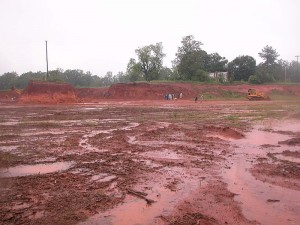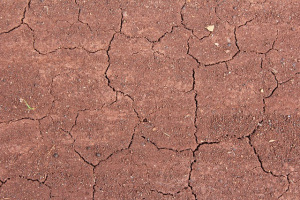
Red clay or red mud, is the common name for a variety of ultisol found in the SE United States. Residents who live in the area often speak poorly of the soil, although in fact it isn’t as poor as all that. Some dislike it because it is hard to keep their clothes and homes clean. The USDA’s “Soil Taxonomy – 2nd Edition” includes ultisols among its twelve soil orders. Red clay is rich in weathered minerals. Over time, rain leaches out soil calcium, magnesium and potassium. This makes a soil ‘old.’ Particles in such soils are smaller than 2.0 microns. The red color is due to iron oxide.
General Clay Composition
Clays include the kaolinite of red ultisol and are usually made up of complex silicate minerals. Tulane University explains they are 2D 6-member ring sheet silicates called phyllosilicates. Due to weathering, the sheets are fragmented. They readily slide across each other. This imparts slipperiness. Moisture is held in the ring structures.
Red Clay Horizons
Soils, including red mud, are divided into layers. There are organic, topsoil, subsoil, parent material and bedrock layers. Junctures between layers are horizons. The layers are visible in cutaway images. These images may include a measuring stick. See this cutaway of red Georgia clay.
In Construction, Forestry and Agriculture
Red clay has low organic matter. It is stable for construction purposes. Forests thrive in it. When forests are cleared by slash and burn methods, fertility quickly goes. Although some clays are not suitable for farming, the red variety is workable. Calcium and fertilizer amendments are necessary for repeat farming. So while red soil may present a cleaning problem, it can be an asset if properly utilized.
Note: You might also enjoy Cement Production Aggravates Carbon Dioxide Levels
References:
- U of Idaho: The Twelve Orders of Soil Taxonomy: Ultisols
- NCSU: Soil Science Courseware: Ultisols
- USDA: What are Soil Horizons?
← Back to Classic Science
← Home

Lack of glaciation has a lot to do with how red clay is formed.
Frankly, I tend not to think in terms of glaciers as really doing or accomplishing all the things some give them credit for. Like trapping mammoths with food in their mouths. Like: how fast did glaciers travel? Fast enough to “outrun” mammoths? Nonsense. And the lack of glaciers should mean even less. Actually, with the exception of possessing little to no organic matter, I’ve been rather under the impression red clay is well-suited for crops.
I mentioned glaciation because it plays a part in how soils are formed. In the southern USA, that region mostly escaped being covered in an ice sheet. For that reason, it was subjected to massive rainfall and leaching of minerals. In many places, glaciation helped replenish the soil because of the constant scraping of soil and rock. In the southern USA, there was largely no replenishing of new soil.
I understand what you are saying. I say what I said, because in view of the Bible, I’m not sure at all that glaciation has anything to do with matters. It’s rather like evolution. As a scientist, I find the teaching of evolution ridiculous.
I don’t even worry about reconciling science and faith. I look at science as having to do with something testable. Faith, is about faith. Faith isn’t about what is scientifically proven, it is about faith. One reason I don’t worry about evolution.
Hi, guy. I hear you. Sadly, faith isn’t accurately defined by the churches. As defined in the Bible at Hebrews 11:1, “Faith is the assured expectation of what is hoped for, the evident demonstration of realities that are not seen.” It is sure, it is certain. Science must conform to Biblical precepts. In fact, I have always found they do, without flaw. Much of what is attributed by some scientists to glaciers was actually a result of the flood. At the polar regions, freezing was quick, entrapping animals ordinarily found in a much warmer climate (which existed before the flood). I’d love to carry on a one-on-one discussion on this. Email me if interested. Address is on the QuirkyScience homepage.
What a crazy little spot in the interverse.
[…] soil just so, especially in a place like central Virginia—where you get a chunky and weathered red clay that’s like a concrete wall to those spindly little roots trying to make their […]
[…] https://www.quirkyscience.com/red-clay/ […]
[…] https://www.quirkyscience.com/red-clay/ […]
[…] https://www.quirkyscience.com/red-clay/ […]